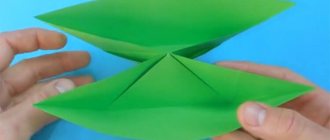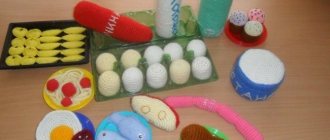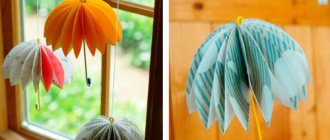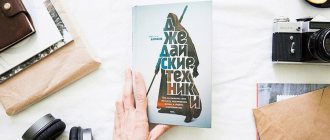Volumetric daisies
Cut 6-10 narrow strips from white office paper. The length can be equal to the length of an A4 sheet:
- Fold the strip in half;
- Apply glue to only a small area in the center of the strip;
- Glue the strip to the base;
- Bend the second sheet, coat it with glue, and glue it perpendicular to the first;
- Repeat with the remaining strips;
- Take the edge of the last glued strip, bend it towards the center, forming a loop, glue;
- Repeat with the other end of the strip;
- Fold and glue each strip to the center;
- Glue a circle of yellow paper to the attachment point - the core of the flower.
The thinner the strips of paper, the more openwork the flower will turn out.
Hedgehog
A hedgehog made from a plastic bottle and fir branches is suitable as a craft made from natural material in the older group:
- Wrap a 0.5 liter plastic bottle with string from the cap to the beginning of the wide part;
- Coat the rest of the bottle with plasticine;
- Glue fir cones onto plasticine;
- Glue doll eyes or eyes made of cardboard/buttons onto the muzzle;
- Decorate the needles with a viburnum sprig or a yellow leaf.
Stork
On the rough sketch, sketch out the outline of the bird. Turn the leaf over and seal it with double-sided tape, because large seeds are better attached to tape.
Just don’t peel off the protective film from the tape just yet; first you need to cut out the picture along the contour and glue it to the background.
We expose the tape and glue white plumage made from pumpkin seeds and black plumage from sunflower seeds onto it.
You can simply draw the beak and legs with a felt-tip pen, or you can pour semolina onto PVA and then paint it with gouache.
The nest can be made from branches, sushi sticks, dry grass, and pencil sawdust.
Owl
On a dark background you need to glue the first rosette, slightly unfolded - the body. Next the head is glued on. For this, you also need to stretch the corrugated part and cut out a small bow on top to make ears.
The wings will be made from rosettes folded in half, and the belly and eyes will be made from small or cut off ones. To finish, you need to use felt-tip pens to draw in the feathers, beak, pupils, and paws.
Cardboard cactus
- Decorate a white paper cup to suit your taste. This will be a cactus pot;
- Cut out 3 ovals from double-sided green cardstock;
- Fold each oval in half lengthwise;
- Glue the ovals like this. Coat one of the halves with glue, attach the second oval to it so that the two halves are connected and the other two stick out;
- Using the same technique, glue the third oval.
Place the resulting cactus in a pot. If desired, you can draw spines on the cactus or add a flower to it.
Clown
Not all crafts in the older group bring moms and dads a lot of trouble. Sometimes it’s enough to print out a drawing from the Internet and give the child some thread.
- Print or draw a clown face;
- Glue the drawing onto a sheet of thick cardboard;
- Make holes in the top of the head using a hole punch or awl;
- Invite your child to make a clown's hair using pieces of multi-colored yarn. Pieces of yarn need to be threaded through the holes and tied with a knot.
Paper chickens
In the photos of crafts in the senior group of kindergarten you can often see voluminous paper crafts. Using this technique you can make, for example, chickens:
- Roll a sheet of yellow paper into a bag to make a cone;
- Trim the edges of the cone so that it stands firmly on the table;
- Cut out a scallop and paws from orange or red paper;
- Glue the paws to the base of the cone and the tuft to the top;
- Draw the chicken's eyes and beak.
Pasta art
Pasta is often used for children's crafts in the older group. Different types of pasta can be used for different crafts.
For the “sun” applique, you can use round pasta that looks like wheels, feather pasta is suitable for creating a Christmas tree, and pasta horns are suitable for decorating the curly fur of a sheep. Raw pasta should be glued onto a cardboard or paper base and, if desired, decorated.





